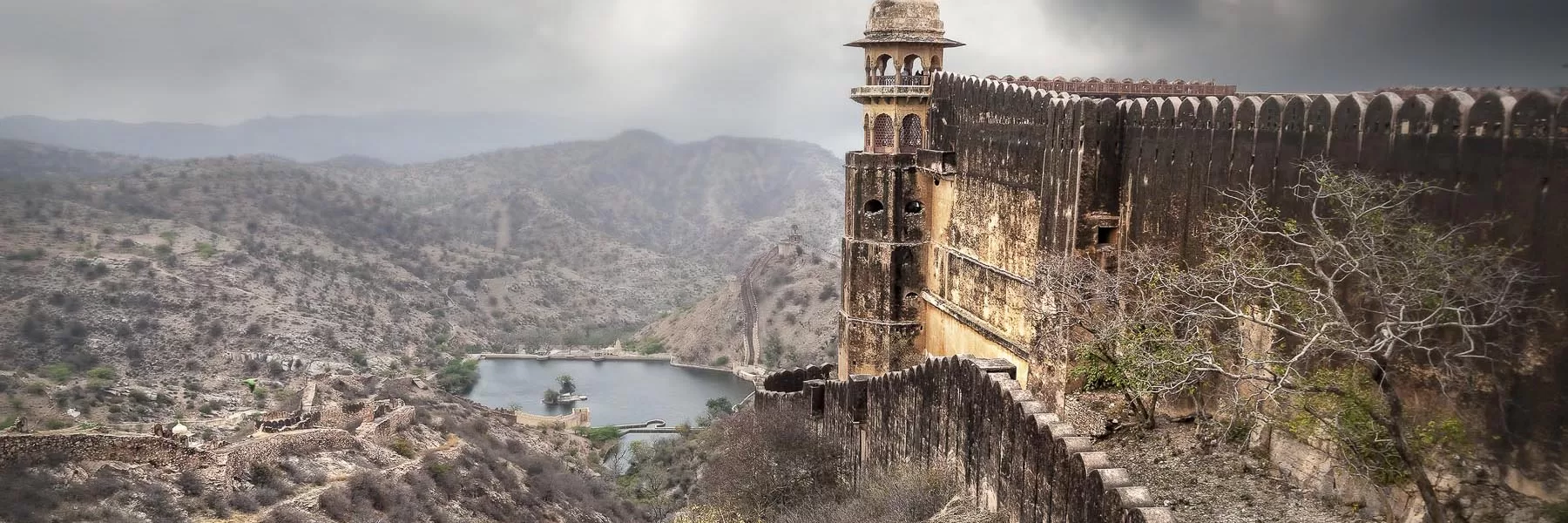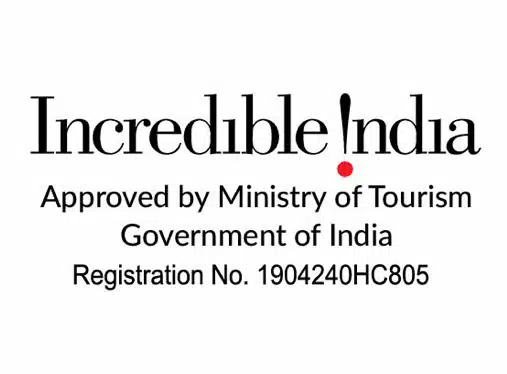1. Amer Fort, Jaipur
Also known as Amber Fort, this fort is one of the most majestic and most-visited forts in India. Amer Fort is just 11kms from the main city and is situated atop a small hill and overlooks the Maotha Lake. This extensive palace is constructed out of pale yellow and pink limestone and contains many serpentine staircases and maze-like passages. Once the capital of the erstwhile princely Jaipur state, Amer Fort was declared a UNESCO World Heritage site in 2013.
Getting There
You enter Amer Fort via the Chand Pol. Other conveyance options take you through the Suraj Pol. Both the gates lead to the main courtyard, called Jaleb Chowk. The sprawling court has numerous sections, living quarters, temples, gardens, etc. The fort remains open from 8 a.m. to 5.30 p.m. and then reopens from 6.30 p.m. to 9.15 p.m., during which, visitors enjoy the evening light and sound show, night viewing, followed by dinner.
What to see
The most popular spots inside Amer Fort are diwan-e-aam, Sheesh Mahal, Shila Devi temple, and a series of underground tunnels. You can also have a look at the beautiful architecture of Amer Fort by visiting the four courtyards and living quarters.

Amer fort
2. Chittorgarh
Situated about 175 kilometres to the east of Udaipur, Chittorgarh Fort is regarded as the symbol of Rajput bravery, gallantry, and honour. The fort is a UNESCO World Heritage Site and was built in the 7th century AD by the Mewar kingdom. Sprawling across an area of 700 acres, this majestic fort sits atop a 180-metre-high hill, on the banks of river Berach. A kilometer-long road takes you up to the rampart, having passed through seven gates, namely Ganesh gate, Hanuman gate, Padan gate, Bhairon gate, Jodla gate, Lakshman gate, and the main gate, Ram gate.
Getting There
Chittorgarh is 200 km away from Udaipur, 300 km from Jaipur, and 312 km from Jodhpur. The nearest airport is in Udaipur, from where you can hire a taxi, which is approximately a 2-hour drive. If you wish to reach here by train, Chittorgarh Junction is just 6km away from Chittorgarh Fort. Accommodation options in Chittorgarh include the Chittorgarh Fort Haveli, Hotel Royal Inn, and Elegance Resort. One can also stay in Udaipur city which has a lot of hotels, and then make the journey to Chittorgarh. The fort is free to enter and open at all times. However, some specific monuments have entry fees.
What to see
Chittorgarh Fort has four palaces, 22 water bodies (there used to be 84 water bodies in the past), four memorials, and many temples. The fort itself is a marvel of ancient architecture. There are two prominent towers, namely Kirti Stambha (Tower of Fame) and Vijay Stambha (Tower of Victory). The most popular palaces worth visiting in Chittorgarh are Rana Kumbha Palace, Padmini’s Palace, and Fateh Prakash Palace. Shopping enthusiasts should visit the Rana Sanga Market, famous for its collection of jewelry, handicrafts, and local art. To appreciate the rich history of this place, a trip to the Chittorgarh museum is recommended.

Chittorgarh fort
3. Bhangarh Fort, Alwar
Notorious for being the most haunted place in India, this 17th-century fort is located at the borders of Sariska Tiger Reserve in Alwar district of Rajasthan. There are many stories on how Bhangarh Fort came to become haunted, but all of them revolve around some sort of a curse. This fort is not for the faint of the heart; visitors of this place claim to have heard ghosts scream, eerie smells, voices of crying women, unusual sounds of music, and sounds of bangles. People have also reported ghostly shadows and strange lights. With all these spooky tales and myths, this is an exceptionally intriguing place to visit.
Getting there
The nearest airport is Jaipur and the nearest railway station is Bandikul. Bhangarh Fort is 220 km away from Delhi and accessible by road. Owing to the lack of provision of electricity, entry to the fort is restricted before sunrise and after sunset. You can also club Bhangarh visit with a safari to Sariska.
What to see
There are several palaces (Havelis) and temples spread across the fort. Remains of Hanuman Tempe and Gopinath Temple, as well as a temple dedicated to Mangala Devi and Ganesh, can be found here. Apart from the fort, you can also visit Sariska Reserve, Ajabgarh Fort, Chand Baori, and Alwar.

Bhangarh fort
4. Taragarh Fort, Bundi
Taragarh Fort in Ajmer was built in 1354 A.D., under the reign of king Ajaypal Chauhan. The fort is located on a steep hill and offers beautiful picturesque views of the entire city of Bundi. During Mughal rule, the fort was used as a military center and during the British rule, it was used as a sanatorium. Taragarh Fort is an excellent and magnificent example of Rajasthani culture.
Getting there
The closest airport to Taragarh is Jaipur, at a distance of 126 km. The nearest railway station is Ajmer Junction, 2.4 km away. Highways connect Taragarh to all major cities of India and regular buses ply on those routes. The best time to visit this fort is during winter, from November to March when you can walk across the fort in the pleasant weather.
What to see
Three huge and distinctive gateways engraved with carvings of elephants welcome you to Taragarh Fort. They are known as Gagudi ki Phatak, Phuta Darwaza, and Lakshmi Pol. One must visit the Bhim Burj, a huge 16th-century bastion on which rests the giant cannon, Garbh Gunjan. Another top-rated tourist attraction here is the Rani Mahal, famous for its murals and stained-glass windows. You can also pay a visit to Miran Saheb ki Dargah.

Bundi fort
5. Mehrangarh Fort, Jodhpur
Perched upon a hill at 125m, Mehrangarh Fort is one of the largest forts in India, located right at the edge of the Thar Desert in Jodhpur city. The fort was built in 1438 by Rao Jodha. It spreads across 5 km in the heart of the city. This magnificent fort is known for its glorious architecture and diverse history. The fort can be accessed by one of its seven gates, each built by a different ruler in honour of victories over Jaipur and Bikaner armies.
Getting there
Located in the middle of Jodhpur city, this fort is easily accessible. Jodhpur can be reached by air, train, or road. While entry to the fort is free, you may need to buy tickets for special attractions. The fort is reachable by a 15-minutes’ walk from the old city. Your vehicle can drop you till the gate of the fort.
What to see
Mehrangarh Fort has some vast palaces, most famous of which are Phool Mahal, Moti Mahal, Takht Vilas, Sheesh Mahal, Zenana Dude, and Jhanki Mahal. The fort also contains two temples- Nagnechiaji Mandir and Chamundi Devi Mandir. If you wish to explore the diverse history of Mehrangarh, you can visit the Mehrangarh Museum, which contains a collection of furniture, paintings, royal cradles, arms, costumes, musical instruments, and palanquins. You can enjoy the rich culture of this place, represented beautifully by musical performances of people wearing traditional Rajasthani costumes. Nearby attractions include Jaswant Thada and Umaid Bhavan Palace.

Mehrangarh Fort
6. Junagarh Fort, Bikaner
Initially called “Chintamani” and later renamed to Junagarh in the 20th century, this majestic fort is one of the most impressive in India. This is one of the few Indian forts that wasn’t built on a hilltop. The exquisite structures of this fort, showcasing architectural brilliance attract thousands of tourists every year. A unique historical fact about this fort is that Junagarh remains unconquered over all this time, despite thousands of attempts by invaders.
Getting there
Junagarh fort sits at the heart of Bikaner city; the entire city was developed around the fort. It can be accessed easily by cars, taxis, buses, and auto-rickshaws. Bikaner city has good connectivity with all major neighboring cities. Jodhpur is 235 km away, Jaipur is 354 km, and Delhi is 458 km. Bikaner railway station is also well connected and many trains, including the luxurious “Palace on Wheels” make their stop at Bikaner. The nearest airport is in Jodhpur, from where you can get taxis and buses.
What to see
The fort complex consists of courtyards, pavilions, 37 palaces, and balconies, all decorated with paintings, marbles, and carved stones. One of the most impressive structures of Junagarh Fort is Anup Mahal, notable for its red and gold-colored walls. Badal Mahal is another beautiful palace, where you can find pillars with intricate patterns, covered with gold leaves. Har Narayan temple is the royal temple of the fort. The Ratan Bihari temple is also located near Junagarh fort.

Bikaner fort
7. Jaisalmer Fort, Jaisalmer
Jaisalmer fort was built in the year 1156, the same year when Jaisalmer city was founded. At least five lookouts spread throughout the fort grant the tourists great views of the city and the sprawling Thar Desert. Jaisalmer Fort is one of the very few “living forts” in the world, with nearly a quarter of the old city’s population residing within the fort’s walls. The fort is also called “Sonar Kila” because it is made from yellow sandstone.
Getting there
Jaisalmer city is very well connected with major cities of India. You can arrive here by road, rail, or air. Transportation within the city is good, your vehicle can drop you till main gate of the fort. The fort has four gateways- Suraj Pol, Akshya Pol, Hawa Pol, and Ganesh Pol. A paved road takes you from the city, up a ramp, and through these gateways.
What to see
The Islamic and Rajput style of architecture in Jaisalmer Fort is truly a sight to behold. Tourists can visit numerous architectural buildings inside the fort, like houses, palaces, and temples. The most imposing of these is the Palace of Maharawal, former home of the monarch. The palace has since been converted into a museum that contains beautifully painted and tiles rooms with lots of paintings and artwork. Other places to visit are Raj Mahal (Royal Palace), and temples like Jain temple and Laxminath temple.

Jaisalmer fort
8. Jaigarh Fort, Jaipur
Jaigarh Fort was built in 1726 AD by Sawan Jai Singh. This 3 km long and 1 km wide stronghold is also known as Victory Fort and is notable for housing the world’s largest cannon on wheels- Jaivana Cannon. The fort is architecturally similar to Amer Fort and was built to protect the latter. Perched on top of a cliff at a height of 500 feet, and surrounded by verdant greenery, Jaigarh Fort offers panoramic views of Jaipur.
Getting there
The fort is located inside Jaipur city, so connectivity is really good. The nearest airport is Jaipur airport, which is connected to all major Indian cities. Within the city, one can hire taxis, buses, and auto-rickshaws to take them to the fort.
What to see
Jaigarh Fort has brilliantly constructed courtrooms, assembly halls, and temples. One must also visit the nearby Amer Fort, which has its opulent structures and magnificent architecture, apart from a sound and light show that takes place at Amer during the evenings. The 400 years old Shila Devi temple and Panna Meena ka Kund are two other must-visit places at Jaigarh. To experience the rich history of this place more closely, you can visit the Anokhi Museum of Hand Printing, where you can buy local handicrafts and authentic textiles.

Jaigarh Fort
9. Kumbhalgarh Fort, Udaipur
Notable for its 38km long wall, second only to the Great Wall of China, this 1100-meter tall fort is a magnificent citadel and a major tourist attraction. This UNESCO Heritage World site sits at a strategic location in the Aravalli Hills. The fort has been built in the Rajput military architectural style and makes use of the defensive properties of the terrain. Kumbhalgarh Fort, with its imposing height, offers splendid views of the surroundings.
Getting there
The nearest airport is at Udaipur, 84 km from the fort. Udaipur city is well connected with all major Indian cities by road, rail, and air. You can take a taxi or bus from Udaipur to reach the fort. Kumbhalgarh is also reachable by train, the nearest station is Falna Railway Station.
What to see
Notable temples here include Neelkanth Mahadev Temple, Parsvanath Temple, Bawan Devi Temple, Vedi Temple, and Ganesh temple. Kumbhalgarh Fort houses the Kumbha Palace- a double-storeyed structure built in classic Rajput style, adorned with beautiful paintings and architecture. It offers beautiful views of the fort and the surrounding landscape. Other popular spots include Jhalia ka Malia, the birthplace of Maharana Pratap, and Nimbu Pol.

Kumbhalgarh fort
10. Ranthambore Fort, Jaipur
Founded in the 10th century by the Chauhan Rajputs, this majestic fort has become a famous haunt for tourists visiting Ranthambore National Park. The fort sits on the steep cliff of Thambhore Hill and is surrounded by sprawling forest. It covers an area of 4 miles and is filled with numerous ruins of temples, palaces, pavilions, interspersed with a network of courtyards and lanes. Once considered an epitome of power, having defended the Rajput Empire against numerous attacks, this magnificent fort is now a famous tourist attraction that appeals to historians and common people alike.
Getting there
The nearest airport is in Jaipur, located 180 km away. Tourists can avail taxis or buses from the airport. The nearest railway station is Sawai Madhopur Station, located at a distance of 10km from the fort. The fort is reachable by taxis and auto-rickshaws. The best time to visit is from April to October.
What to see
Ranthambore Fort is a great example of Rajasthani architecture. Visitors can relive the Rajput era by visiting the towering domes, gates (there are seven major gates), temples, stone pathways, and water tanks. Other attractions include Sametonki Haveli, Toran Dwar, and Mahadeo Chhatri. The Ganesha Temple attracts large crowds of devotees. There are many wildlife safaris also available, that take you across the surrounding Ranthambore National Park.
If you loved reading this story, then subscribe to our blog here (it will ask to verify your email) to get inspiring travel stories and trivia delivered to your email. Stories about wildlife trivia, cultural experiences, curated luxury hotel lists, underrated places to travel, polar journeys and much more.











